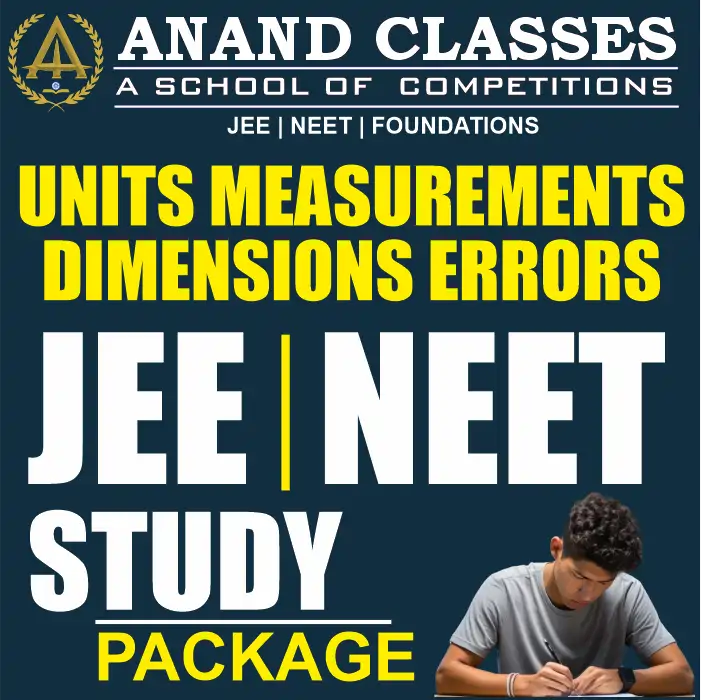Projectile Motion Notes With JEE NEET MCQS Physics Class 11 CBSE Study Material Full Chapter Download pdf-Anand Classes
What Is Projectile?
A projectile is any object thrown into space upon which the only acting force is gravity. The primary force acting on a projectile is gravity. This doesn’t necessarily mean that other forces do not act on it, just that their effect is minimal compared to gravity. The path followed by a projectile is known as a trajectory. A baseball batted or thrown is an example of a projectile.
What Is Projectile Motion?
When a particle is thrown obliquely near the earth’s surface, it moves along a curved path under constant acceleration directed towards the centre of the earth (we assume that the particle remains close to the earth’s surface). The path of such a particle is called a projectile, and the motion is called projectile motion.
In a Projectile Motion, there are two simultaneous independent rectilinear motions:
- Along the x-axis: uniform velocity, responsible for the horizontal (forward) motion of the particle.
- Along the y-axis: uniform acceleration, responsible for the vertical (downwards) motion of the particle.
Acceleration in the horizontal projectile motion and vertical projectile motion of a particle: When a particle is projected in the air with some speed, the only force acting on it during its time in the air is the acceleration due to gravity (g). This acceleration acts vertically downward. There is no acceleration in the horizontal direction, which means that the velocity of the particle in the horizontal direction remains constant.
Projectile Motion
When a particle is projected obliquely near the earth’s surface, it moves in horizontal as well as vertical directions simultaneously. The motion of such a particle is known as the projectile motion.
Rectilinear motions involved in projectile motion are:
Two independent simultaneous motions are responsible for projectile motion.
- X-axis: uniform velocity is accountable for the horizontal motion of the particle (forward movement).
- Y-axis: uniform acceleration is accountable for the vertical motion of the particle (downward movement).
Projectile motion is categorised into:
- Horizontal motion
- Vertical motion
What Is Horizontal Motion?
Did you know the only force acting upon a projectile is gravity? Gravity proceeds to impact the vertical motion of the projectile generating a vertical acceleration. A projectile’s horizontal motion is the result of the tendency of any object to persist the motion at a constant velocity. Since horizontal forces are absent, the projectile continues to be in motion at a constant horizontal velocity. Here, to keep a projectile moving horizontally, horizontal forces are not necessary. The horizontal motion of a projectile is independent of its vertical motion.
The motion of a projectile in a horizontal plane, which depends upon the force acting on it, is known as horizontal motion. It was the great scientist Galileo, who first put forth the independence of the horizontal and the vertical components of projectile motion in his dialogue on the great world systems.
The horizontal component of the speed of a projectile is constant throughout the flight duration. Since after launching the projectile, no horizontal force acts on it. This is the reason the projectile travels horizontally at a constant speed. Let us know how to calculate the distance covered by a projectile.
Distance = speed × Time
d = vt
Examples of Horizontal Motion
After learning the definition of horizontal motion, let us know some examples of horizontal motion.
- A boat travelling in a river.
- A bullet fired from a gun.
- Throwing a ball or a cannonball.
- Movement of a billiard ball on the billiard table.
- The motion of the planet Earth around the Sun.
MCQs Projectile Motion
Q1: A stone is just released from the window of a train moving along a horizontal straight track. The stone will hit the ground following
- Hyperbolic path
- Straight path
- Circular path
- Parabolic path
Answer: (d) Parabolic path
Q2: A bullet is dropped from the same height when another bullet is fired horizontally. They will hit the ground
- Simultaneously
- Depends on the observer
- One after the other
- None of the above
Answer: (b) Simultaneously
Q3: A bomb is dropped from an aeroplane moving horizontally at a constant speed. When air resistance is taken into consideration, the bomb
- Flies with the aeroplane
- Falls to earth behind the aeroplane
- Falls to earth ahead of the plane
- Falls to earth exactly below the aeroplane
Answer: (b) Falls to earth behind the aeroplane
Q4: The maximum range of gum on horizontal terrain is 16 km. If g = 10 m/s2. What must be the muzzle velocity of the shell?
- 400 m/s
- 100 m/s
- 200 m/s
- 50 m/s
Answer: (a) 400 m/s
Q5: An aeroplane flying 490 m above ground level at 100 m/s, releases a block. How far on the ground will it strike?
- 2 km
- 0.1 km
- 1 km
- None
Answer: (c) 1 km
Q6: A man projects a coin upwards from the gate of a uniformly moving train. The path of coin for the man will be
- Vertical straight line
- Inclined straight line
- Parabolic
- Horizontal straight line
Answer: (a) Vertical straight line
Q7: A particle A is dropped from a height and another particle B is thrown in a horizontal direction with the speed of 5m/sec from the same height. The correct statement is
- Particle B will reach the ground first
- Both particles will reach the ground with the same speed
- Particle A will reach the ground first
- Both particles will reach the ground simultaneously
Answer: (d) Both particles will reach the ground simultaneously
Q8: A particle moves in a plane with constant acceleration in a direction from the initial velocity. The path of the particle will be
- A parabola
- An ellipse
- A straight line
- An arc of a circle
Answer: (a) A parabola
Q9: An aeroplane moving horizontally with a speed of 720 km/h drops a food packet while flying at a height of 396.9m. The time taken by the food packet to reach the ground and its horizontal range is
- 9 sec and 1800 m
- 5 sec and 500 m
- 8 sec and 1500 m
- 3 sec and 2000 m
Answer: (a) 9 sec and 1800 m
Q10: At the height 80 m, an aeroplane is moving with 150 m/s. A bomb is dropped from it so as to hit a target. At what distance from the target should the bomb be dropped
- 600 m
- 605.3 m
- 80 m
- 230 m
Answer: (a) 600 m
Frequently Asked Questions – FAQs
What is a projectile?
What is a trajectory?
Define time of flight.
State true or false: the minimum number of coordinates required to completely define the motion of a body determines the dimension of its motion.
Define projectile motion?
What is the use of the projectile motion formula?
What is the projectile motion formula also known as?
The projectile motion formula is also known as the trajectory formula.
Define trajectory.
State true or false: A projectile is an object upon which the only force acting is gravity.
What is horizontal motion?
The motion of a projectile in a horizontal plane, which depends upon the force acting on it, is known as horizontal motion.
What is the formula to calculate the distance covered by a projectile?
Distance = speed × Time
d = vt
What is the only force acting upon a projectile?
The only force acting upon a projectile is gravity.
State true or false: A bullet fired from a gun is an example of circular motion.
How is projectile motion categorised?
Projectile motion is categorised into:
- Horizontal motion
- Vertical motion
Keywords
projectile motion class 11, projectile motion class 11 derivation, projectile motion class 11 questions, projectile motion class 11 numericals, projectile motion class 11 chapter name, projectile motion class 11 pdf, projectile motion class 11 formulas, projectile motion class 11 notes pdf, projectile motion class 11 which chapter, projectile motion class 11 numericals with answers pdf, projectile motion notes, projectile motion notes pdf, projectile motion notes pdf class 11, projectile motion notes jee, projectile motion notes in hindi, projectile motion notes class 11th, projectile motion notes ppt, projectile motion notes a level, projectile motion notes a level pdf, projectile motion notes physics, projectile motion jee mains questions, projectile motion jee advanced questions, projectile motion jee mains pyq, projectile motion jee notes, projectile motion jee, projectile motion jee mains, projectile motion jee question, projectile motion jee pyqs, projectile motion jee advanced pyq, is projectile motion important for jee, projectile motion neet questions, projectile motion neet questions pdf, projectile motion neetprep, projectile motion neet notes, projectile motion neet formula sheet, projectile motion mcq for neet pdf, projectile motion mcq for neet, projectile motion class 11 neet, projectile motion previous year neet questions, projectile motion class 11 definition


































